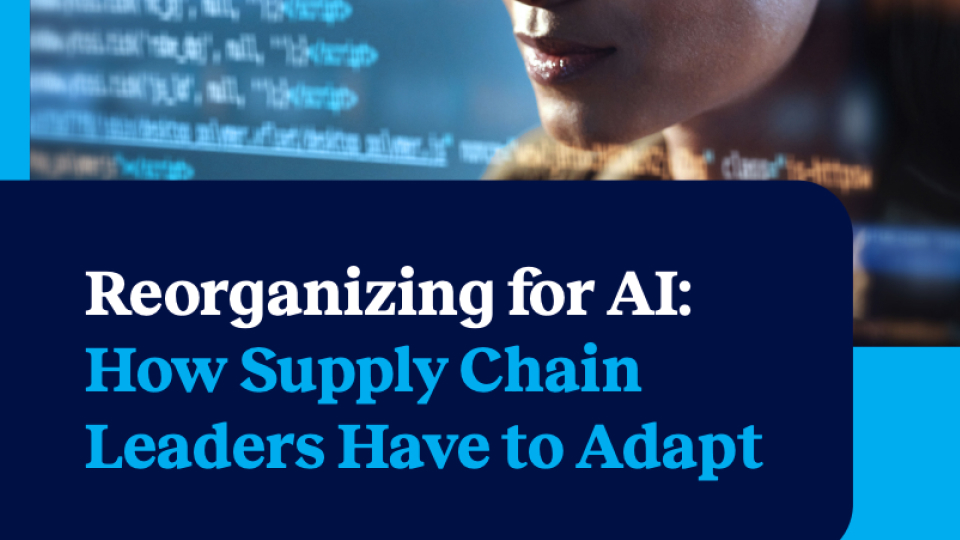Le concept de chaîne d'approvisionnement est né de la création de la chaîne de montage, qui remonte au début du 20e siècle. Chaque fonction, de la planification à la livraison, avait sa place. Et si tout le monde fait sa part, comme dans une machine bien huilée, les fabricants peuvent s'attendre à des marges et à une croissance élevées. Cela a si bien fonctionné que les fabricants ont modernisé la gestion de la chaîne d'approvisionnement en introduisant la technologie et l'automatisation pour les aider à avancer plus rapidement et plus intelligemment. Mais les fondements de la chaîne d'approvisionnement restaient liés à l'approche linéaire, cloisonnée et rigide des débuts de la production de masse.
Le problème est que le monde d'aujourd'hui est très différent du paysage commercial de 1905 - ou même de 2015. L'optimisation au niveau fonctionnel, axée sur l'obtention du coût le plus bas, ne produira plus les meilleurs résultats possibles pour l'organisation. Les systèmes cloisonnés ne peuvent plus faire face au rythme du changement, ni offrir l'agilité nécessaire pour suivre l'évolution de la demande des clients, les perturbations du marché et la complexité croissante de la chaîne d'approvisionnement.
Les chefs d'entreprise de tous les secteurs savent qu'ils ont besoin d'une nouvelle approche. Ils veulent une chaîne d'approvisionnement moderne, résiliente et entièrement optimisée pour apporter le plus grand profit possible à leurs organisations. Qui ne le ferait pas ?
Le défi est de savoir par où commencer. Cet article de blog vous guidera à travers les étapes clés à suivre pour accroître la résilience et la rentabilité de la chaîne d'approvisionnement - en passant au cloud et en tirant pleinement parti de l'innovation technologique disponible aujourd'hui.
Étape 1 : Utiliser l'informatique dématérialisée comme tremplin pour la transformation numérique
Les entreprises d'aujourd'hui veulent une chaîne d'approvisionnement moderne, résiliente et entièrement optimisée. Pour y parvenir, ils doivent d'abord passer à l'informatique dématérialisée. En passant des ressources informatiques sur site à l'informatique en nuage, les entreprises peuvent atteindre un niveau d'agilité et de rapidité nettement plus élevé, ce qui leur permet de pivoter et de se réorienter à la volée en réponse aux perturbations de la chaîne d'approvisionnement.
Les entreprises ont également la possibilité de consommer l'innovation plus rapidement et à moindre coût. Avec les piles technologiques internes, la mise à niveau vers de nouvelles fonctionnalités prend du temps et coûte cher. Mais sur le cloud, cela peut se faire en quelques minutes ou quelques jours, au lieu de mois ou d'années. Enfin, les entreprises sont en mesure de traiter l'information - en exécutant des scénarios dans les domaines du merchandising, de la fabrication, de la logistique, de l'entreposage et de la distribution, le tout en même temps, avec une puissance de calcul illimitée. Ils peuvent s'agrandir et se réduire rapidement, à la demande. Au lieu d'utiliser une unité centrale pendant 100 heures, les entreprises peuvent utiliser 100 unités centrales pendant une heure, ce qui réduit le temps de planification de plusieurs jours à quelques minutes. Ils ne sont plus contraints par de longs cycles de traitement par lots et peuvent enfin faire un meilleur usage de leurs investissements dans l'intelligence artificielle (IA) et l'apprentissage machine (ML).
Cette rapidité et cette agilité dans la prise de décision seront un aspect essentiel pour déterminer les gagnants et les perdants de la chaîne d'approvisionnement dans les années à venir. Les organisations capables d'élaborer un nouveau scénario basé sur des facteurs de marché en temps réel et de l'exécuter en quelques minutes prendront une longueur d'avance sur la concurrence.
Bien que l'on parle beaucoup de l'informatique dématérialisée dans le domaine de la chaîne d'approvisionnement, le concept de l'informatique dématérialisée a encore du mal à s'imposer pour un certain nombre de raisons, notamment en raison des problèmes d'intégration et de données. Cela nous amène à l'étape 2.















